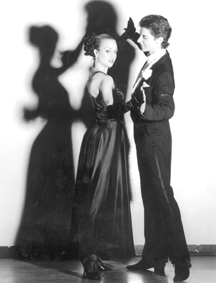

[ Metro | Metroactive Central | Archives ]
Twelve For Ten
Formal Wear: Joanne Jaglowski and Mark Otloski pair up in "U.S."
The ballet shows off a decade's worth of dances
By Philip Collins
SAN JOSE CLEVELAND Ballet celebrated its 10th anniversary this past weekend with a packed program of dances pulled from the company's repertoire. For fans of long standing, it was an evening of chestnuts, some dating back to the Cleveland Ballet's debut 20 years ago.
Artistic director Dennis Nahat selected 12 works that emphasized the occasion's celebratory theme while also putting his company's sterling technique on display. The spirit of this 48-member troupe was infectious from beginning to end; its virtuosities everywhere evident. Thanks to the San Jose Symphony's accompaniment work in the pit and David Guthrie's imaginative design touches--primarily in costuming, though in some of the set pieces as well--the evening was richly textured. Choreography, music and design elements effectively fused to bring out the uniqueness of each work. There was even a slide show chronicling the company's history, during which the orchestra pounded out excerpts from Copland's Rodeo.
Nahat's eclectic appetite alone would have provided sufficient scope to keep things interesting, but his inclusion of two 20th-century revivals--the can-can from Massine's Gaite Parisienne and Balanchine's Tarantella pas de deux--supplied memorable highlights.
Solo spectacles were offered in abundance. Nahat's re-creation of Marius Petipa and Vakhtang Chabukiani's Le Corsaire pas de deux made a dazzling vehicle for Maydee Pena and Roberto Almaguer. Almaguer's leaps defied gravity in their feathery descents, while Pena's spinning pointe work sparkled like sunlight on whitecaps. Together, they moved as one; even when airborne, their trajectories lined perfectly.
Balanchine's Tarantella pas de deux, set to music by Gottschalk, was as acrobatic as ballet gets, with flying twirls, dervish speed and even a bit of tambourine tapping. Karen Gabay and Raymond Rodriguez mined the work's golden opportunities with ignited theatricality.
Principals Ana Lobe and Olivier Munoz jointed handsomely as the center set to Grand pas de dix, Nahat's choreography after Petipa. Amid the ornate pointe maneuvers of two quartets, Lobe and Munoz offered beautifully poised coupling. The choreography included several lifts, and Munoz's transport of Lobe looked as effortless as if he were carrying a napkin.
The program's two solo works, Laura's Women by Ian Horvath (Nahat's co-founding colleague of the Cleveland Ballet), and The Green Table by Kurt Joos were impressively performed, though as compositions, their merits were debatable. In the latter piece, Mark Otloski brought urgency to Koos' mechanistic choreography, supplying some dimension to the work's otherwise stark agenda. Laura's Women benefited from Lisa Alfieri's powerfully focused performance, which rendered the choreography's whiplike contrasts between freezes and discrete pacings with discerning precision.
Horvath's choreographic response to the emotional candor of Poverty Train (set to music by Laura Nyro) maintained a fine balance between head and heart--true to the music's expressive nature while sustaining rigorous formal control.
Massine's Gaite Parisienne could be likened to a decadent, multilayered dessert, savored for its lively ensemble designs and can-cans but nutritionally scant. Guthrie's costuming contributed loudly with cornea-popping show apparel. His costumes, as well as his set designs, sustained a rich life of their own throughout the program. His ideas spoke with a clarity and specificity that suited the medium. Each of the selections operated integrally on multiple levels, each bearing its own distinct flavor.
Summerscape, Nahat's 1982 charmer, opened the program with buoyant spirits and slight disarray. The choreography's lyric windings in and out of Shostakovich's youthful Concerto for Piano and Orchestra No. 2 add lightheartedness to what surely must be one of the composer's most playful soundings. Soloists Lauren Schultz, Laurel Skousen and Adrien Thorne brought personal warmth to the foreground, and Nahat's carefree parlays between traditional Russian ballet style and American-born colloquial gestures--particularly the "can do" strut--clicked persuasively.
The finale, U.S., Nahat and Horvath's chronological review of American dance styles, amounted to one too many cherries on top. The six-part suite was gratifyingly swift and upbeat but dated--retro to a fault.
The San Jose Symphony, conducted by Stanley Sussman, lent staunch support the whole evening, although with little of the nuance one encounters in the orchestra subscription series programming. The symphony's amplification from the pit took some getting used to, and it ultimately prevented any true gelling of textures. Special praise, however, goes to pianist Barbara Bilach for her accomplished playing of the Shostakovich concerto and F.A. Cohen's clamorous score for The Green Table.
[ Metro | Metroactive Central | Archives ] This page was designed and created by the Boulevards team.

Steve Vaccariello
From the May 2-8, 1996 issue of Metro
Copyright © 1996 Metro Publishing and Virtual Valley, Inc.